Implementation Plan: Reducing CRE Infections in Boston Children's
VerifiedAdded on 2023/04/22
|6
|1406
|378
Report
AI Summary
This report presents an implementation plan to reduce Carbapenem-resistant Enterobacteriaceae (CRE) infections within a healthcare setting, specifically targeting the Paediatric Care Unit at Boston Children’s Hospital. The plan includes a budget of $4000-$5000, focusing on a one-day hands-on workshop and seminar to educate healthcare professionals about CRE prevention. Key resources involve securing an auditorium, demonstrating proper hand hygiene and PEP equipment usage, and engaging a physician and Advanced Nurse Practitioner to lead the sessions. The methodology involves pre and post workshop surveys using quantitative statistical analysis to measure the effectiveness of the training. The implementation includes discussions on screening procedures, antibiotic prescriptions, and strategies to overcome potential barriers such as space unavailability or participant absenteeism. The evaluation plan involves monitoring participant attentiveness and analyzing survey responses to continuously improve the program and ensure positive patient outcomes. Desklib provides access to this and other solved assignments.
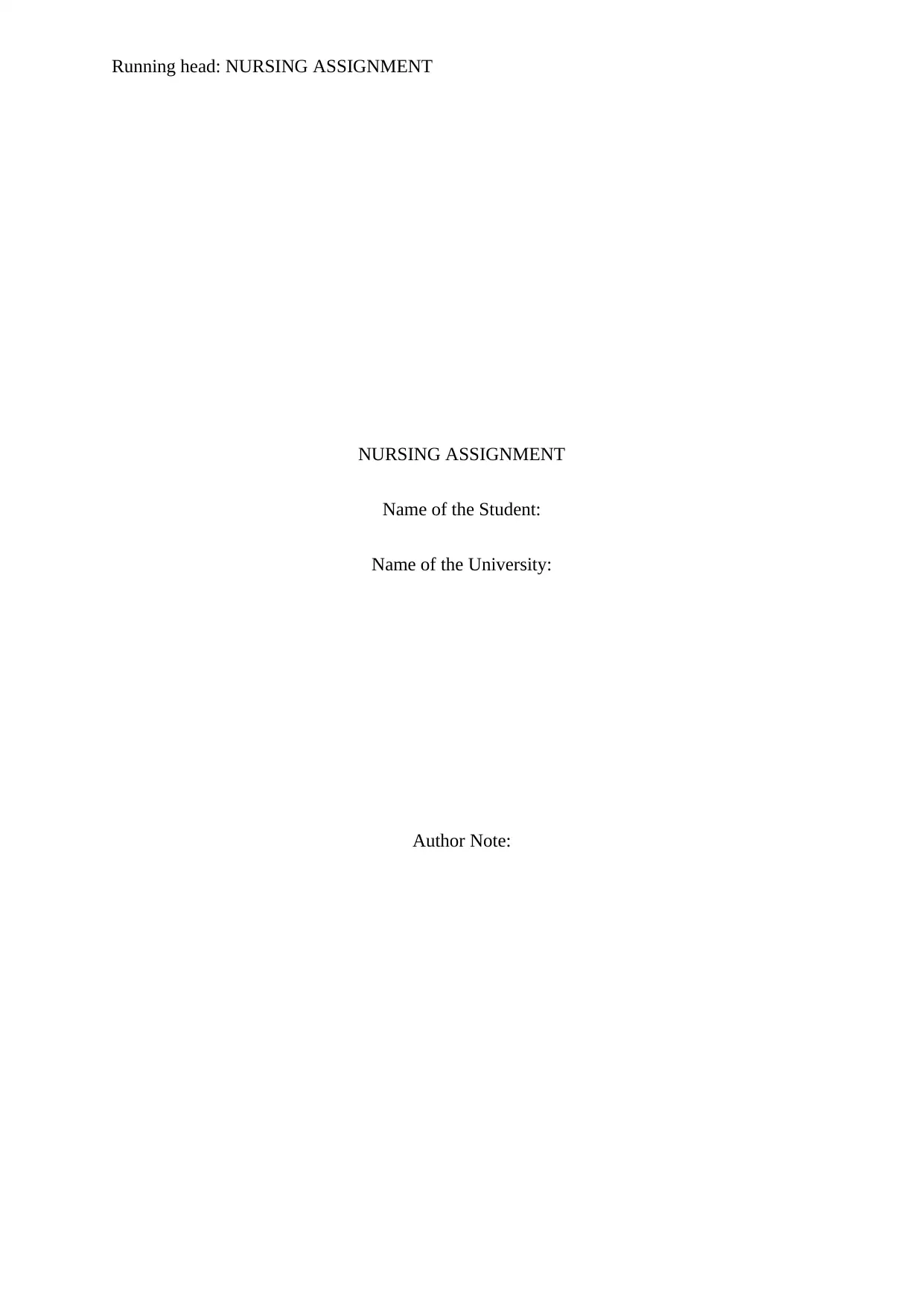
Running head: NURSING ASSIGNMENT
NURSING ASSIGNMENT
Name of the Student:
Name of the University:
Author Note:
NURSING ASSIGNMENT
Name of the Student:
Name of the University:
Author Note:
Paraphrase This Document
Need a fresh take? Get an instant paraphrase of this document with our AI Paraphraser
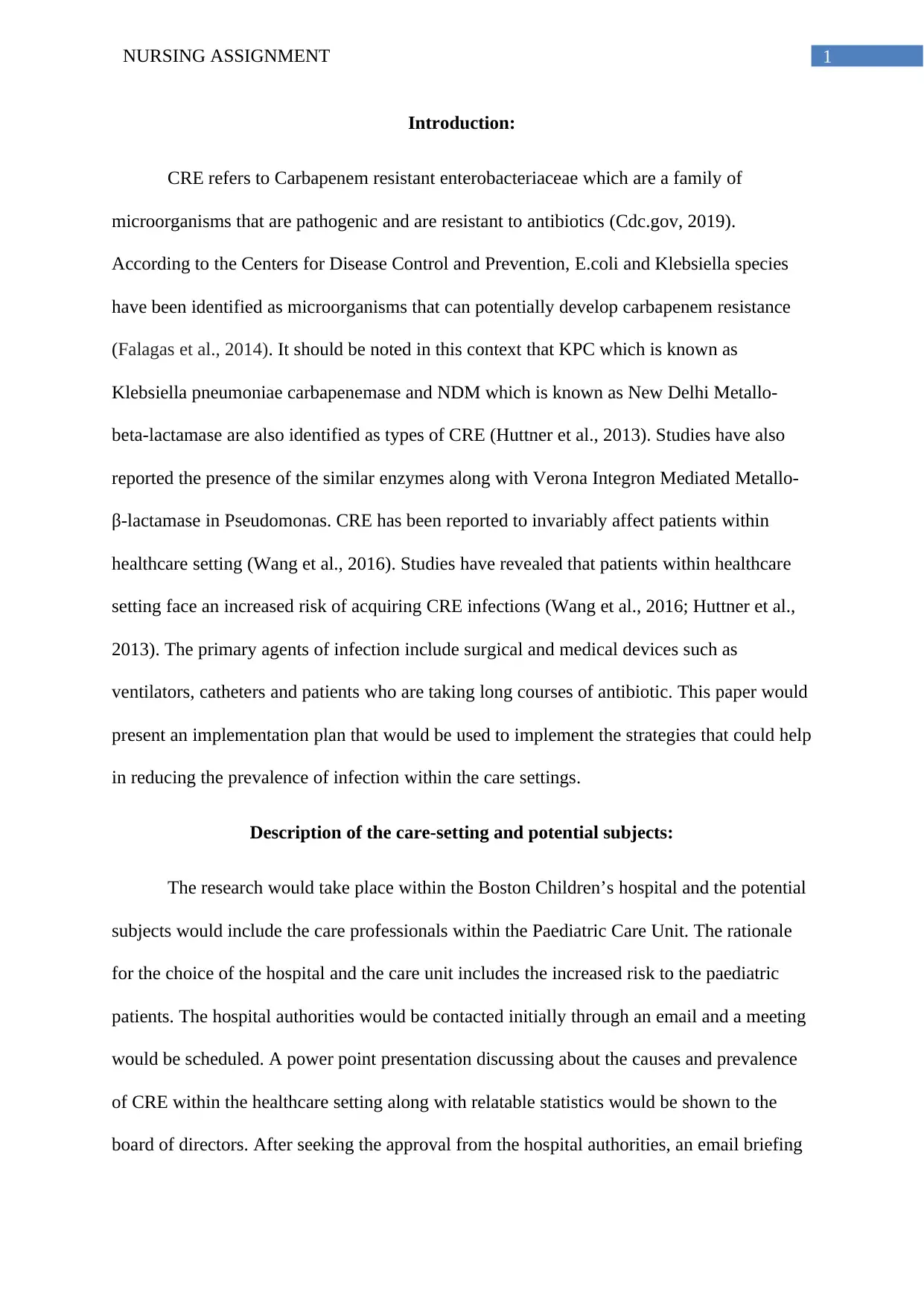
1NURSING ASSIGNMENT
Introduction:
CRE refers to Carbapenem resistant enterobacteriaceae which are a family of
microorganisms that are pathogenic and are resistant to antibiotics (Cdc.gov, 2019).
According to the Centers for Disease Control and Prevention, E.coli and Klebsiella species
have been identified as microorganisms that can potentially develop carbapenem resistance
(Falagas et al., 2014). It should be noted in this context that KPC which is known as
Klebsiella pneumoniae carbapenemase and NDM which is known as New Delhi Metallo-
beta-lactamase are also identified as types of CRE (Huttner et al., 2013). Studies have also
reported the presence of the similar enzymes along with Verona Integron Mediated Metallo-
β-lactamase in Pseudomonas. CRE has been reported to invariably affect patients within
healthcare setting (Wang et al., 2016). Studies have revealed that patients within healthcare
setting face an increased risk of acquiring CRE infections (Wang et al., 2016; Huttner et al.,
2013). The primary agents of infection include surgical and medical devices such as
ventilators, catheters and patients who are taking long courses of antibiotic. This paper would
present an implementation plan that would be used to implement the strategies that could help
in reducing the prevalence of infection within the care settings.
Description of the care-setting and potential subjects:
The research would take place within the Boston Children’s hospital and the potential
subjects would include the care professionals within the Paediatric Care Unit. The rationale
for the choice of the hospital and the care unit includes the increased risk to the paediatric
patients. The hospital authorities would be contacted initially through an email and a meeting
would be scheduled. A power point presentation discussing about the causes and prevalence
of CRE within the healthcare setting along with relatable statistics would be shown to the
board of directors. After seeking the approval from the hospital authorities, an email briefing
Introduction:
CRE refers to Carbapenem resistant enterobacteriaceae which are a family of
microorganisms that are pathogenic and are resistant to antibiotics (Cdc.gov, 2019).
According to the Centers for Disease Control and Prevention, E.coli and Klebsiella species
have been identified as microorganisms that can potentially develop carbapenem resistance
(Falagas et al., 2014). It should be noted in this context that KPC which is known as
Klebsiella pneumoniae carbapenemase and NDM which is known as New Delhi Metallo-
beta-lactamase are also identified as types of CRE (Huttner et al., 2013). Studies have also
reported the presence of the similar enzymes along with Verona Integron Mediated Metallo-
β-lactamase in Pseudomonas. CRE has been reported to invariably affect patients within
healthcare setting (Wang et al., 2016). Studies have revealed that patients within healthcare
setting face an increased risk of acquiring CRE infections (Wang et al., 2016; Huttner et al.,
2013). The primary agents of infection include surgical and medical devices such as
ventilators, catheters and patients who are taking long courses of antibiotic. This paper would
present an implementation plan that would be used to implement the strategies that could help
in reducing the prevalence of infection within the care settings.
Description of the care-setting and potential subjects:
The research would take place within the Boston Children’s hospital and the potential
subjects would include the care professionals within the Paediatric Care Unit. The rationale
for the choice of the hospital and the care unit includes the increased risk to the paediatric
patients. The hospital authorities would be contacted initially through an email and a meeting
would be scheduled. A power point presentation discussing about the causes and prevalence
of CRE within the healthcare setting along with relatable statistics would be shown to the
board of directors. After seeking the approval from the hospital authorities, an email briefing
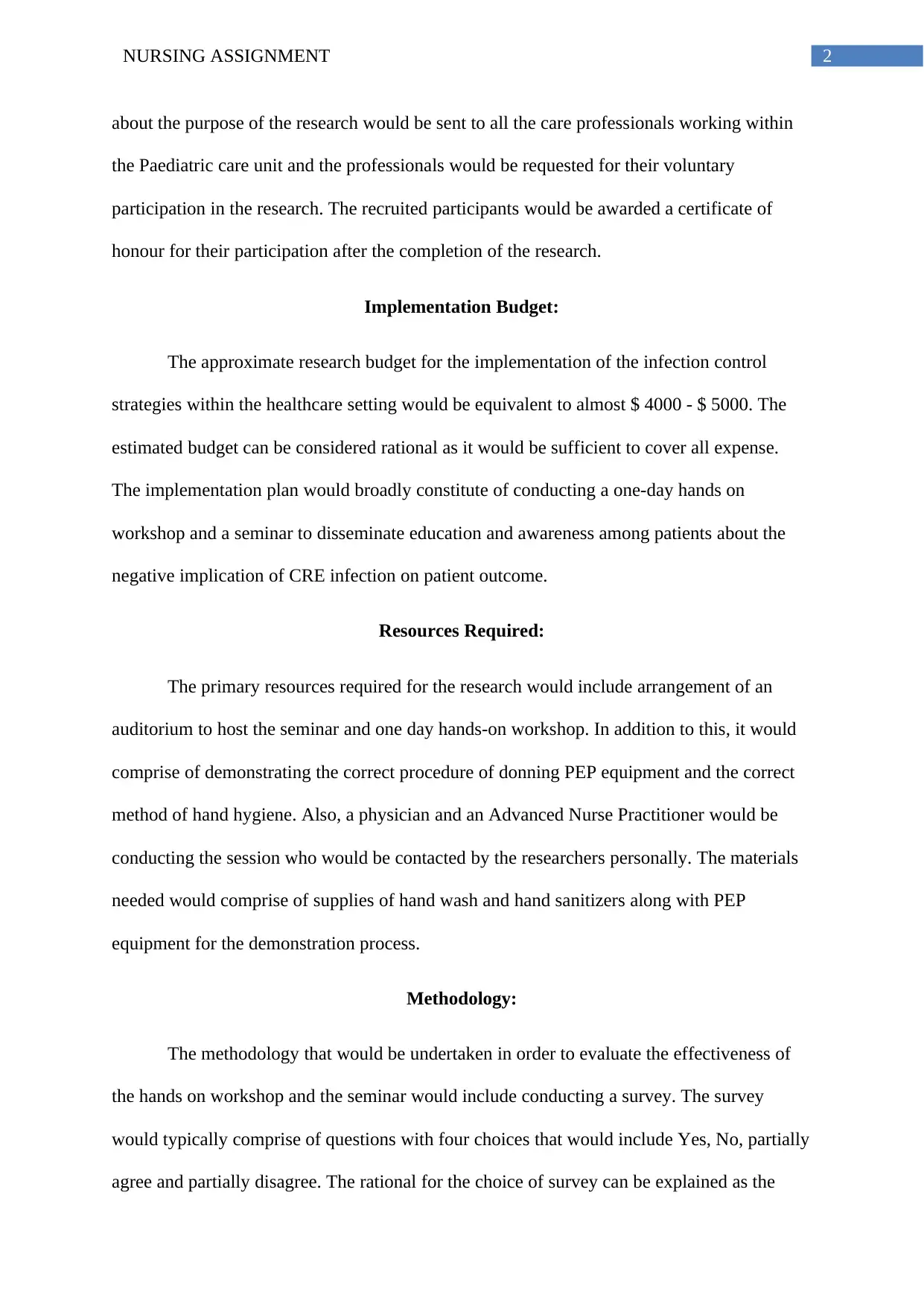
2NURSING ASSIGNMENT
about the purpose of the research would be sent to all the care professionals working within
the Paediatric care unit and the professionals would be requested for their voluntary
participation in the research. The recruited participants would be awarded a certificate of
honour for their participation after the completion of the research.
Implementation Budget:
The approximate research budget for the implementation of the infection control
strategies within the healthcare setting would be equivalent to almost $ 4000 - $ 5000. The
estimated budget can be considered rational as it would be sufficient to cover all expense.
The implementation plan would broadly constitute of conducting a one-day hands on
workshop and a seminar to disseminate education and awareness among patients about the
negative implication of CRE infection on patient outcome.
Resources Required:
The primary resources required for the research would include arrangement of an
auditorium to host the seminar and one day hands-on workshop. In addition to this, it would
comprise of demonstrating the correct procedure of donning PEP equipment and the correct
method of hand hygiene. Also, a physician and an Advanced Nurse Practitioner would be
conducting the session who would be contacted by the researchers personally. The materials
needed would comprise of supplies of hand wash and hand sanitizers along with PEP
equipment for the demonstration process.
Methodology:
The methodology that would be undertaken in order to evaluate the effectiveness of
the hands on workshop and the seminar would include conducting a survey. The survey
would typically comprise of questions with four choices that would include Yes, No, partially
agree and partially disagree. The rational for the choice of survey can be explained as the
about the purpose of the research would be sent to all the care professionals working within
the Paediatric care unit and the professionals would be requested for their voluntary
participation in the research. The recruited participants would be awarded a certificate of
honour for their participation after the completion of the research.
Implementation Budget:
The approximate research budget for the implementation of the infection control
strategies within the healthcare setting would be equivalent to almost $ 4000 - $ 5000. The
estimated budget can be considered rational as it would be sufficient to cover all expense.
The implementation plan would broadly constitute of conducting a one-day hands on
workshop and a seminar to disseminate education and awareness among patients about the
negative implication of CRE infection on patient outcome.
Resources Required:
The primary resources required for the research would include arrangement of an
auditorium to host the seminar and one day hands-on workshop. In addition to this, it would
comprise of demonstrating the correct procedure of donning PEP equipment and the correct
method of hand hygiene. Also, a physician and an Advanced Nurse Practitioner would be
conducting the session who would be contacted by the researchers personally. The materials
needed would comprise of supplies of hand wash and hand sanitizers along with PEP
equipment for the demonstration process.
Methodology:
The methodology that would be undertaken in order to evaluate the effectiveness of
the hands on workshop and the seminar would include conducting a survey. The survey
would typically comprise of questions with four choices that would include Yes, No, partially
agree and partially disagree. The rational for the choice of survey can be explained as the
⊘ This is a preview!⊘
Do you want full access?
Subscribe today to unlock all pages.

Trusted by 1+ million students worldwide
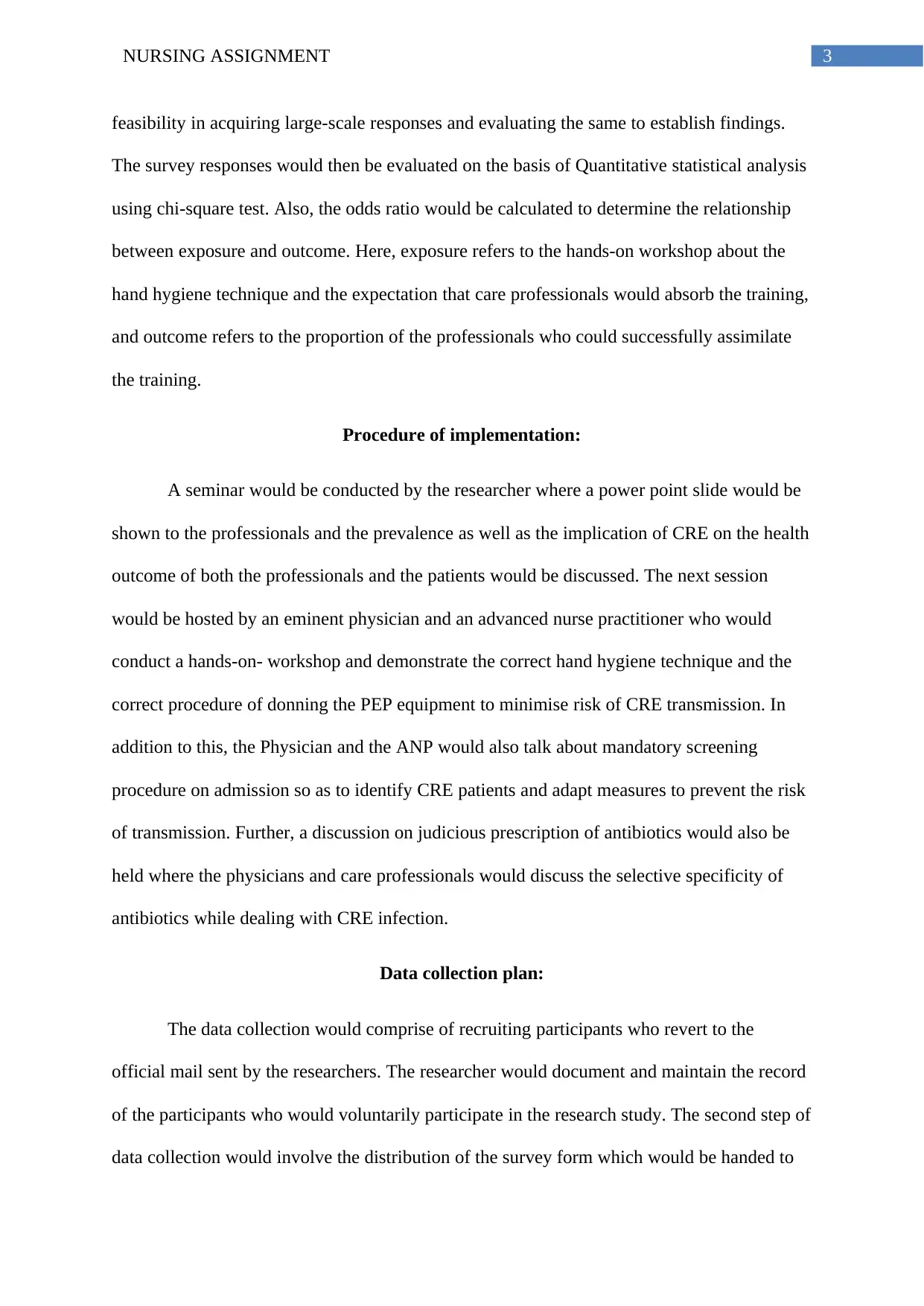
3NURSING ASSIGNMENT
feasibility in acquiring large-scale responses and evaluating the same to establish findings.
The survey responses would then be evaluated on the basis of Quantitative statistical analysis
using chi-square test. Also, the odds ratio would be calculated to determine the relationship
between exposure and outcome. Here, exposure refers to the hands-on workshop about the
hand hygiene technique and the expectation that care professionals would absorb the training,
and outcome refers to the proportion of the professionals who could successfully assimilate
the training.
Procedure of implementation:
A seminar would be conducted by the researcher where a power point slide would be
shown to the professionals and the prevalence as well as the implication of CRE on the health
outcome of both the professionals and the patients would be discussed. The next session
would be hosted by an eminent physician and an advanced nurse practitioner who would
conduct a hands-on- workshop and demonstrate the correct hand hygiene technique and the
correct procedure of donning the PEP equipment to minimise risk of CRE transmission. In
addition to this, the Physician and the ANP would also talk about mandatory screening
procedure on admission so as to identify CRE patients and adapt measures to prevent the risk
of transmission. Further, a discussion on judicious prescription of antibiotics would also be
held where the physicians and care professionals would discuss the selective specificity of
antibiotics while dealing with CRE infection.
Data collection plan:
The data collection would comprise of recruiting participants who revert to the
official mail sent by the researchers. The researcher would document and maintain the record
of the participants who would voluntarily participate in the research study. The second step of
data collection would involve the distribution of the survey form which would be handed to
feasibility in acquiring large-scale responses and evaluating the same to establish findings.
The survey responses would then be evaluated on the basis of Quantitative statistical analysis
using chi-square test. Also, the odds ratio would be calculated to determine the relationship
between exposure and outcome. Here, exposure refers to the hands-on workshop about the
hand hygiene technique and the expectation that care professionals would absorb the training,
and outcome refers to the proportion of the professionals who could successfully assimilate
the training.
Procedure of implementation:
A seminar would be conducted by the researcher where a power point slide would be
shown to the professionals and the prevalence as well as the implication of CRE on the health
outcome of both the professionals and the patients would be discussed. The next session
would be hosted by an eminent physician and an advanced nurse practitioner who would
conduct a hands-on- workshop and demonstrate the correct hand hygiene technique and the
correct procedure of donning the PEP equipment to minimise risk of CRE transmission. In
addition to this, the Physician and the ANP would also talk about mandatory screening
procedure on admission so as to identify CRE patients and adapt measures to prevent the risk
of transmission. Further, a discussion on judicious prescription of antibiotics would also be
held where the physicians and care professionals would discuss the selective specificity of
antibiotics while dealing with CRE infection.
Data collection plan:
The data collection would comprise of recruiting participants who revert to the
official mail sent by the researchers. The researcher would document and maintain the record
of the participants who would voluntarily participate in the research study. The second step of
data collection would involve the distribution of the survey form which would be handed to
Paraphrase This Document
Need a fresh take? Get an instant paraphrase of this document with our AI Paraphraser
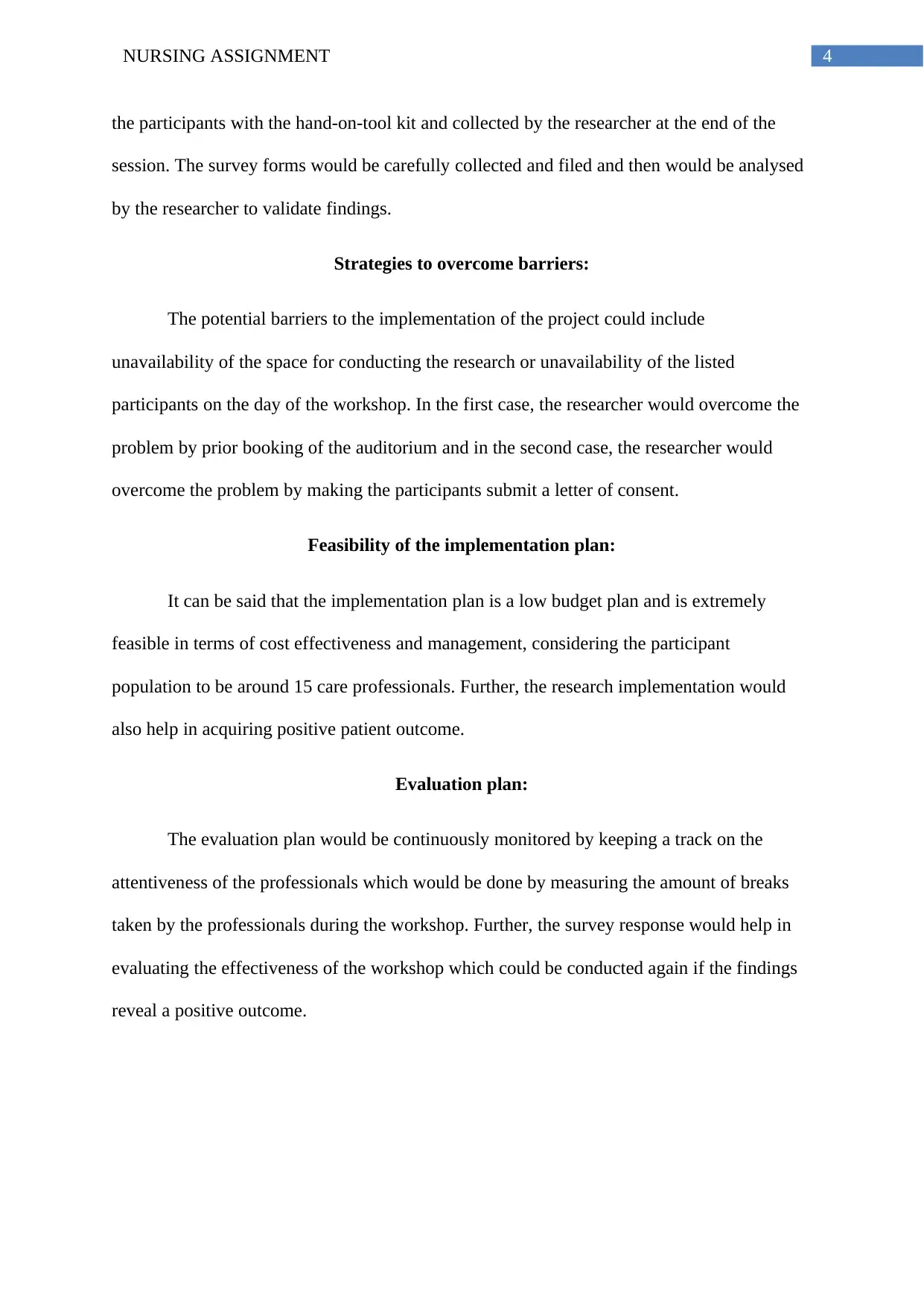
4NURSING ASSIGNMENT
the participants with the hand-on-tool kit and collected by the researcher at the end of the
session. The survey forms would be carefully collected and filed and then would be analysed
by the researcher to validate findings.
Strategies to overcome barriers:
The potential barriers to the implementation of the project could include
unavailability of the space for conducting the research or unavailability of the listed
participants on the day of the workshop. In the first case, the researcher would overcome the
problem by prior booking of the auditorium and in the second case, the researcher would
overcome the problem by making the participants submit a letter of consent.
Feasibility of the implementation plan:
It can be said that the implementation plan is a low budget plan and is extremely
feasible in terms of cost effectiveness and management, considering the participant
population to be around 15 care professionals. Further, the research implementation would
also help in acquiring positive patient outcome.
Evaluation plan:
The evaluation plan would be continuously monitored by keeping a track on the
attentiveness of the professionals which would be done by measuring the amount of breaks
taken by the professionals during the workshop. Further, the survey response would help in
evaluating the effectiveness of the workshop which could be conducted again if the findings
reveal a positive outcome.
the participants with the hand-on-tool kit and collected by the researcher at the end of the
session. The survey forms would be carefully collected and filed and then would be analysed
by the researcher to validate findings.
Strategies to overcome barriers:
The potential barriers to the implementation of the project could include
unavailability of the space for conducting the research or unavailability of the listed
participants on the day of the workshop. In the first case, the researcher would overcome the
problem by prior booking of the auditorium and in the second case, the researcher would
overcome the problem by making the participants submit a letter of consent.
Feasibility of the implementation plan:
It can be said that the implementation plan is a low budget plan and is extremely
feasible in terms of cost effectiveness and management, considering the participant
population to be around 15 care professionals. Further, the research implementation would
also help in acquiring positive patient outcome.
Evaluation plan:
The evaluation plan would be continuously monitored by keeping a track on the
attentiveness of the professionals which would be done by measuring the amount of breaks
taken by the professionals during the workshop. Further, the survey response would help in
evaluating the effectiveness of the workshop which could be conducted again if the findings
reveal a positive outcome.
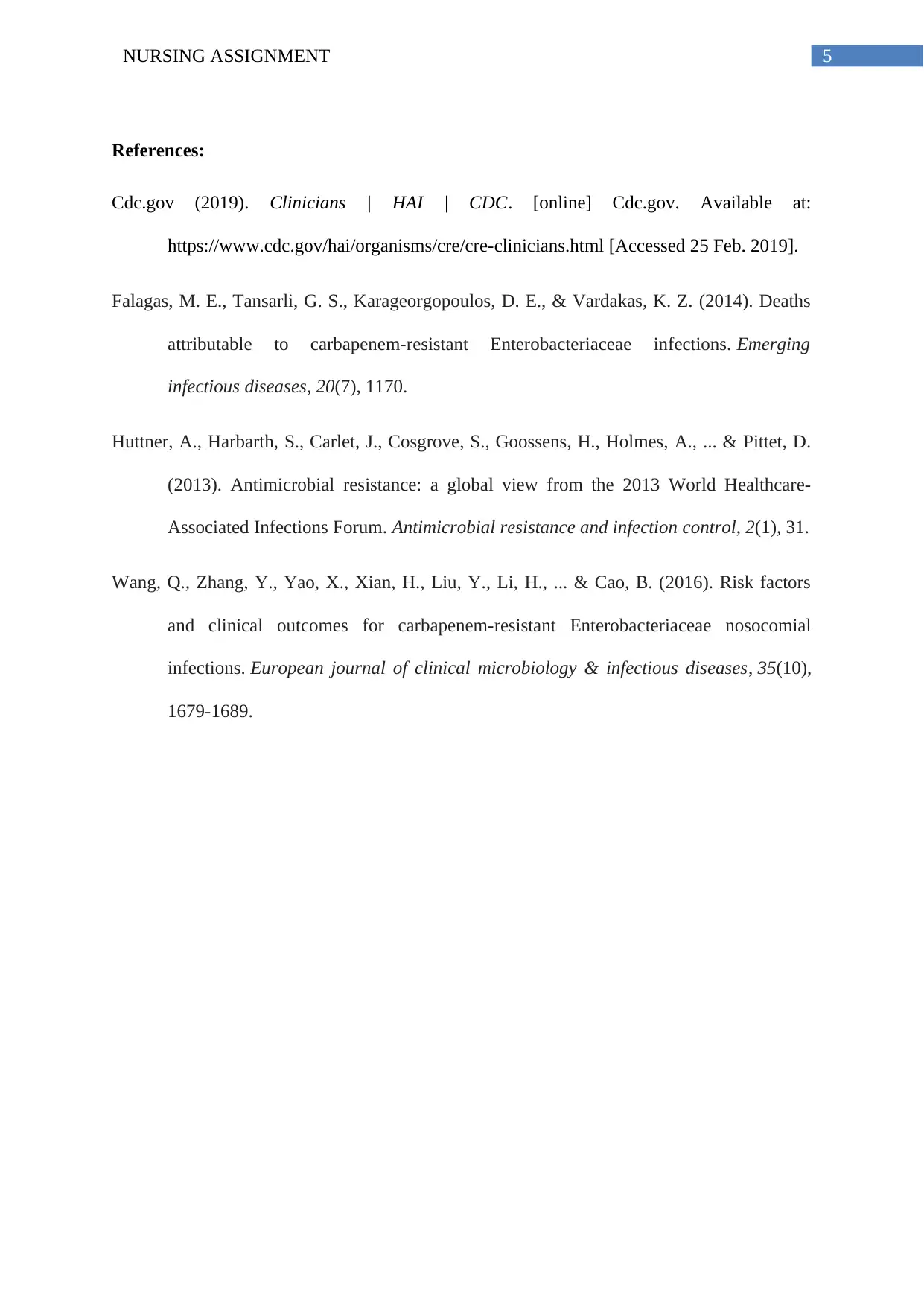
5NURSING ASSIGNMENT
References:
Cdc.gov (2019). Clinicians | HAI | CDC. [online] Cdc.gov. Available at:
https://www.cdc.gov/hai/organisms/cre/cre-clinicians.html [Accessed 25 Feb. 2019].
Falagas, M. E., Tansarli, G. S., Karageorgopoulos, D. E., & Vardakas, K. Z. (2014). Deaths
attributable to carbapenem-resistant Enterobacteriaceae infections. Emerging
infectious diseases, 20(7), 1170.
Huttner, A., Harbarth, S., Carlet, J., Cosgrove, S., Goossens, H., Holmes, A., ... & Pittet, D.
(2013). Antimicrobial resistance: a global view from the 2013 World Healthcare-
Associated Infections Forum. Antimicrobial resistance and infection control, 2(1), 31.
Wang, Q., Zhang, Y., Yao, X., Xian, H., Liu, Y., Li, H., ... & Cao, B. (2016). Risk factors
and clinical outcomes for carbapenem-resistant Enterobacteriaceae nosocomial
infections. European journal of clinical microbiology & infectious diseases, 35(10),
1679-1689.
References:
Cdc.gov (2019). Clinicians | HAI | CDC. [online] Cdc.gov. Available at:
https://www.cdc.gov/hai/organisms/cre/cre-clinicians.html [Accessed 25 Feb. 2019].
Falagas, M. E., Tansarli, G. S., Karageorgopoulos, D. E., & Vardakas, K. Z. (2014). Deaths
attributable to carbapenem-resistant Enterobacteriaceae infections. Emerging
infectious diseases, 20(7), 1170.
Huttner, A., Harbarth, S., Carlet, J., Cosgrove, S., Goossens, H., Holmes, A., ... & Pittet, D.
(2013). Antimicrobial resistance: a global view from the 2013 World Healthcare-
Associated Infections Forum. Antimicrobial resistance and infection control, 2(1), 31.
Wang, Q., Zhang, Y., Yao, X., Xian, H., Liu, Y., Li, H., ... & Cao, B. (2016). Risk factors
and clinical outcomes for carbapenem-resistant Enterobacteriaceae nosocomial
infections. European journal of clinical microbiology & infectious diseases, 35(10),
1679-1689.
⊘ This is a preview!⊘
Do you want full access?
Subscribe today to unlock all pages.

Trusted by 1+ million students worldwide
1 out of 6
Related Documents
Your All-in-One AI-Powered Toolkit for Academic Success.
+13062052269
info@desklib.com
Available 24*7 on WhatsApp / Email
![[object Object]](/_next/static/media/star-bottom.7253800d.svg)
Unlock your academic potential
Copyright © 2020–2025 A2Z Services. All Rights Reserved. Developed and managed by ZUCOL.





